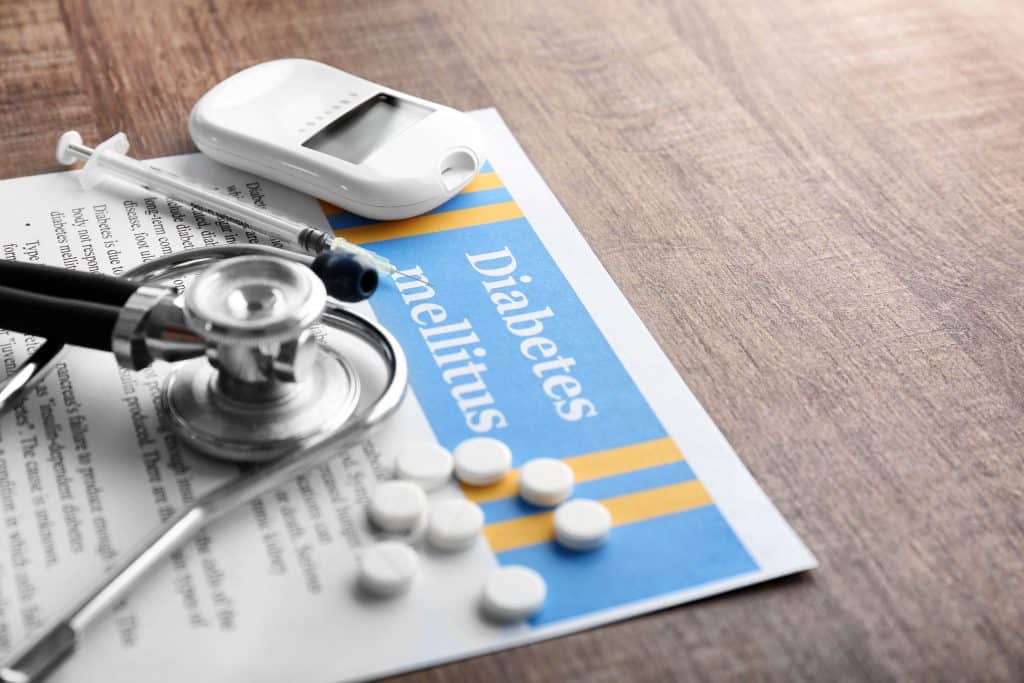National Diabetes Awareness Month: What You Need to Know
Posted by Mike Sonneveldt - See Editorial Guidelines (Last Updated On: Mon Feb 12 2024)

Most of us have heard of diabetes, but what many may not know is that recognition of the condition could be vital for ourselves or our loved ones. To promote that awareness, America celebrates National Diabetes Awareness Month in November. It helps address, promote, and provide support to both those who have it and those who may just be learning about it.
Today, it is estimated that around 37 million Americans have diabetes. On top of that, another 37 million Americans have prediabetes, meaning they are close to becoming diabetic.
Not only do millions of Americans have diabetes, but the National Institute of Diabetes and Digestive and Kidney Diseases estimates that over 8 million adults have diabetes but have gone undiagnosed. Left undiagnosed, the condition can lead to dangerous health complications.
Thankfully, help and resources exist to give support to those who live with diabetes, and encourage awareness to those who may not even realize they have it.
If you are looking for more information about diabetes and how to save money on your diabetes medication, Prescription Hope is here help!

A Quick Background on Diabetes Awareness
In 1975, the U.S. Established National Diabetes Awareness Month to help give exposure to the disease and support research to battle the condition. Congress began officially recognizing the month in the early 1980’s. The International Diabetes Federation started an international diabetes awareness day in 1991, with the United Nations making it official in 2006.
The day selected for an international diabetes awareness day, November 14th, honors Dr. Frederick Banting’s birthday. Dr. Banting co-discovered insulin in 1921, changing the lives of hundreds of millions forever. The discovery led to insulin becoming the most important and effective medication to treat diabetes, with the first person receiving an insulin injection in 1922.
The WHO estimates that in 2014, 422 million people around the world had diabetes, with numbers increasing.
The NIDDK also reports that more than 1 in 3 U.S. Adults ages 18 or older had prediabetes in 2019. This means around 96 million Americans are in danger of becoming diabetic.
Millions of Americans deal with diabetes daily, but there is hope. Plenty of options exist for diabetes support resources, affordable insulin, and supportive communities.
What is Diabetes?
The disease occurs when the body cannot produce insulin or has difficulty in responding correctly to insulin. The hormone insulin absorbs glucose and then uses it as fuel for cells.
Diabetes occurs either when the pancreas is not producing enough insulin, or when the body does not effectively use insulin in regulating blood glucose levels.
However, more than one type of diabetes exists, depending on the source and effect of the disease. Diabetes is divided into two categories: Type 1 and Type 2. Diabetes awareness rests on knowing the difference.
Type 1 Diabetes:
Type 1 diabetes occurs when a person’s body has difficulty or an inability to produce insulin. The body’s immune system attacks the pancreas’ insulin-producing cells. This means the disease classifies as an autoimmune condition. The attack on the body means levels of insulin become low to non-existent, and blood sugar levels rise dangerously high.
Most experts believe that Type 1 diabetes often results from an environmental trigger setting off the autoimmune response in the body. Experts also believe certain genes passed from parent to child make a person susceptible to this autoimmune response. Once triggered, symptoms often show up and provide the signal to seek a diagnosis.
Type 1 symptoms tend to happen rapidly and often include:
- Increases in thirst
- Exhaustion or feeling tired
- Vision blur
- Weight loss
- Heavy breathing
- Nausea and vomiting
- Irritation
- Increase in hunger
Such symptoms are a result of the body losing the ability to produce and use insulin properly. As untreated insulin production decreases over time, the consequences can result in dangerous health complications. The longer diabetes goes undiagnosed and stays untreated, complications become more likely to occur.
Complications of Type 1 Diabetes could include:
- Kidney disease
- Oral health issues
- Vision loss
- Blood vessel damage
- Nerve damage
- Heart disease
- Possible amputation of extremities
Type 1 diabetes can also lead to a condition called Diabetic ketoacidosis. Ketoacidosis occurs when the body cannot find glucose to use as fuel, and instead turns to breaking down fat. As the body breaks down fat, acids called ketones deposit into the bloodstream. A build-up of this acid can cause serious issues, including death.
While risks of the disease may take years to develop, proper management with insulin and medical supervision can provide a long and healthy life. This means that early detection helps patients avoid health complications. Many of those with Type 1 are diagnosed as children, adolescents, and young adults.
Unfortunately, no cure exists for Type 1 diabetes. However, management of the disease can be quite successful. Proper management happens through daily doses of insulin, along with frequent testing of blood glucose levels. Accurate readings of glucose in the blood provide the information needed for the proper dosage of external insulin.

Type 2 Diabetes:
Another name for Type 2 diabetes is adult-onset diabetes. While doctors typically diagnose Type 1 in younger patients, Type 2 often occurs in adulthood, due to prolonged lifestyle choices. These choices result in the body’s cells becoming more and more resistant to insulin.
While cells can become more resistant, that is not the only cause of type 2. The pancreas itself can also have difficulty producing enough insulin to keep blood glucose levels within normal range.
Both issues will result in higher and higher blood glucose levels. Prediabetic fasting blood glucose levels range from 100 to 125 mg/dL. When a person’s fasting blood glucose level rises to 126 mg/dL or higher, they are Type 2 diabetic.
Unfortunately, the symptoms of Type 2 diabetes can be mild or hidden and may take years to recognize. This can delay proper diagnosis. Those symptoms often mirror the symptoms of Type 1, which may include an increase in thirst, exhaustion, vision blur, and more.
Diabetes awareness is life-saving. Type 2 diabetes becomes dangerous when left undiagnosed or untreated. Over the years, the risk of complications from Type 1 diabetes increases. This may result in similar consequences to Type 1 diabetes.
Complications of Type 2 Diabetes could include:
- Heart attack
- Stroke
- Kidney disease
- Vision loss
- Nerve damage, and more
However, lifestyle changes can be effective in treating Type 2, as well as medications, injections, and surgery. Those lifestyle changes might include an improved diet and consistent exercise. Such changes make weight loss a top priority, considering weight issues are often related to Type 2 diabetes.
Finding out you have diabetes through an A1C testing process or similar blood glucose test can be the difference between controlling the condition and dealing with the risks. Anybody who may be at risk should look up diabetes resources such as diabetes diagnosis guides and diabetes testing guides to learn more about the process of dealing with the issue.
What Can You Do To Help Spread Diabetes Awareness?
November has been set aside as National Diabetes Awareness Month to give support to the diabetes community, as well as promote resources to those who may be living with diabetes or prediabetes without knowing it. Sharing resources, such as Prescription Hope’s blog and giving friends and loved ones encouragement to get checked for diabetes could be the help they need to get a diabetes diagnosis and prevent future health risks and complications.

What If I Have Diabetes?
Doctors across the world prescribe insulin as a diabetes treatment. Those who purchase insulin, whether through insurance, rebate programs, Medicare, or out-of-pocket often deal with high costs and strain on their budget. Unfortunately, diabetes awareness suffers due to fears about costs. Considering insulin is a life-saving medication, nobody should have to choose between their insulin or their bills. Instead, finding affordable insulin options or low-cost drugs could be the difference between having what you need or forgoing your insulin.
While various programs exist to help those with diabetes, such programs are often messy and complex. People seek out rebates and government programs but find themselves buried in paperwork and phone calls. Many Prescription assistance programs come with variables. Unfortunately, people get lost and confused trying to find affordable diabetes medication or low-cost insulin.
At Prescription Hope, we offer an affordable and simple process to get affordable insulin options every month.
How It Works
Those who wish to apply can visit PrescriptionHope.com. After becoming familiar with what Prescription Hope offers, you are welcome to complete and submit an online enrollment form. Once you submit the enrollment, Prescription Hope can pre-qualify you as soon as we determine we can assist based on the information provided.
After we receive all the requested paperwork from you and your healthcare provider, the first order of medication often arrives within 2 to 4 weeks. We will then place refills ahead of time so that you receive your medication on a regular schedule.
Medications typically arrive in a 90-day supply, directly to your home or healthcare provider’s office, depending on the requirements of the pharmaceutical company that ships your medication.
Prescription Hope’s Mission to Raise Diabetes Awareness and Help Those with Diabetes
Prescription Hope dedicates itself to helping those with diabetes get the affordable insulin options they need at a reasonable monthly rate. We desire for every member to live without the stress and worry of paying too much for insulin and other vital prescriptions. No one should have to choose between their medication or bills.
We provide a simple, consistent monthly rate of $60.00 per medication for over 1,500 medications. This means that not just people with diabetes can benefit from what we offer. Our heart is to help you get access to affordable prescription medications and insulin cost savings.
If you have been diagnosed with diabetes and are looking for insulin cost savings or affordable diabetes medications, then please visit us at www.PrescriptionHope.com to learn more about how we can save you money every month!


